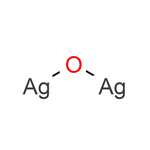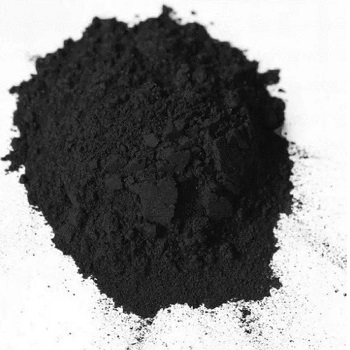- Silver oxide
-

- $0.00 / 1kg
-
2022-09-22
- CAS:20667-12-3
- Min. Order: 1kg
- Purity: 99%
- Supply Ability: 1000kg
- Silver oxide
-

- $10.00 / 1KG/Tin
-
2019-07-06
- CAS:20667-12-3
- Min. Order: 1KG
- Purity: 99%
- Supply Ability: 100
|
| | Silver oxide Chemical Properties |
| Melting point | 300°C (dec.) | | density | 7,143 g/cm3 | | storage temp. | Store below +15°C. | | solubility | insoluble in ethanol; soluble in acid solutions, alkaline solutions | | form | Powder/Solid | | color | Dark-brown | | Specific Gravity | 7.22 | | Water Solubility | slightly soluble | | Sensitive | Light Sensitive | | Merck | 14,8521 | | Stability: | Stable. Oxidiser. Incompatible with most common metals, ammonia, magnesium, many organic materials. | | InChIKey | KHJDQHIZCZTCAE-UHFFFAOYSA-N | | CAS DataBase Reference | 20667-12-3(CAS DataBase Reference) | | EPA Substance Registry System | Silver(I) oxide (20667-12-3) |
| | Silver oxide Usage And Synthesis |
| Chemical Properties | Silver Oxide (Ag2O) is a heavy, brownish black powder, easily reduced by exposure to light. odorless; metallic taste. Soluble in ammonium hydroxide, potassium cyanide solu- tion, nitric acid, and sodium thiosulfate solution; slightly soluble in water; insoluble in alcohol.

Silver Oxide has been known for several centuries, and it is still widely used in synthetic chemistry, including in novel strategies. It has many applications: it can act as a base – due to the presence of oxide –, as an oxidant – due to its easy reduction to metallic silver –, as an halogen scavenger – due to the precipitation of silver halides –, or as a source of silver ion, particularly useful for organometallics preparation. | | Uses | Silver oxide is used for polishing and coloring glass yellow. Also, it is used in purifying drinking water; as a catalyst; and as a germicide and parasiticide.
Silver oxide has been used as a base and halide abstracting agent in the synthesis of areneruthenium metallacyclic complexes of dianionic chelating ligands.
Silver oxide is a potentially valuable regenerative CO2 sorbent for space applications because it is a nontoxic solid that reacts with atmospheric CO2 at room temperature to form nontoxic solid silver carbonate.
| | Preparation | Silver Oxide is prepared by the reaction of aqueous silver nitrate and hydroxide salts.
Ag2O is poorly soluble in all common solvents including water. It is however readily soluble in ammonia, leading the Tollens'reagent which possesses a historical importance in the development of organic chemistry. This also illustrates the fact that (as for other metal-based reagents), properties of Ag2O may depend on the formation of complexes in the reaction medium.
Other commercially important silver chemicals include silver oxide which is used in batteries and silver cyanide which is used in electroplating.
| | Reactions | Mediates monoprotection of symmetrical diols with alkyl halides in good to excellent yield.
Silver(I) oxide may be used to mediate the following processes:
Selective monoalkylation of symmetric diols in the presence of alkyl halide.
Palladium catalyzed cross-coupling of aryl- and alkenylsilanols with organic halides.
Palladium-catalyzed reaction of aryl and alkenyl halides with terminal alkynes to form arylated or alkenylated alkynes, respectively.
| | Chemical Properties | Silver(I) oxide, Ag2O, is made by action of oxygen under pressure on silver at 300 °C, or by precipitation of a silver salt with carbonate-free alkali metal hydroxide; it is covalent, each silver atom (in solid Ag2O) having two collinear bonds and each oxygen atom four tetrahedral ones; two such interpenetrating lattices constitute the structure. | | Physical properties | Brownish-black cubic crystals; density 7.14 g/cm3 at 16°C; begins to decompose around 200°C, decomposition becoming rapid at 250 to 300°C; insoluble in water and ethanol; soluble in acids and alkalis; sparingly soluble in solutions of caustic alkalis; insoluble in alcohol. | | Uses | As catalyst; in the purification of drinking water; in the glass industry (polishing, coloring glass yellow). | | Uses | Silver(I) oxide may be used in the synthesis of following:
- (RS)-malic acid
- 1,2-(o)-benzoquinone
- polysubstituted cyclic ethers
| | Uses | Polishing glass, coloring glass yellow, catalyst, purifying drinking water, lab reagent, carbon dioxide scrubber, and chemical sensors. It is used in the preparation of other silver compounds, and silver-oxide batteries. In organic chemistry, silver oxide finds use as an oxidizing agent for aldehyes to produce carboxylic acids. | | Preparation | Silver(I) oxide is precipitated by mixing solutions of silver nitrate and caustic soda: 2AgNO3 + 2NaOH → Ag2O + 2NaNO3 + H2O. | | General Description | Odorless brown-black solid. Sinks in water. | | Reactivity Profile | Hydrogen sulfide is rapidly oxidized and may ignite in contact with Silver oxide [Bretherick 1979 p. 977]; Mixtures of metal sulfides, gold(III) sulfide, antimony sulfide or mercury (II) sulfide, phosphorus, sulfur, selenium, and selenium disulfide ignite on grinding with the oxide. Ammonia or hydrazine slowly react with Silver oxide forming silver nitride or in the presence of alcohol, silver fulminate may also be produced [Bretherick 1979 p. 203]. Oxidation of magnesium is explosive when warmed with Silver oxide. | | Hazard | Fire and explosion risk in contact with
organic materials or ammonia. | | Health Hazard | Contact with eyes causes mild irritation. If continued for a long period, ingestion or inhalation of silver compounds can cause permanent discoloration of the skin (argyria). | | Fire Hazard | Behavior in Fire: Decomposes into metallic silver and oxygen. If large quantities are involved, the oxygen might increase the intensity of the fire. | | Flammability and Explosibility | Non flammable | | Safety Profile | A poison by intraperitoneal route. Moderately toxic by ingestion. Flammable by chemical reaction; an oxidizing agent. Explodes in contact with ammonia. Incompatible with CuO, (NH3 + ethanol), (hydrazine + ethanol), CO, HzS, Mg, auric sulfide, Sb sulfide, Hg sulfide, nitroalkanes, Se, S, P, K, Na, NaK, seleninyl chloride. See also SILVER COMPOUNDS. | | Purification Methods | Leach the oxide with hot water in a Soxhlet apparatus for several hours to remove any entrained electrolytes. [Glemser & Sauer in Handbook of Preparative Inorganic Chemistry (Ed. Brauer) Academic Press Vol II p 1037 1965.] |
| | Silver oxide Preparation Products And Raw materials |
|